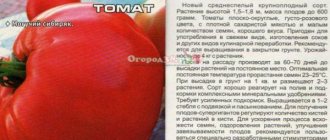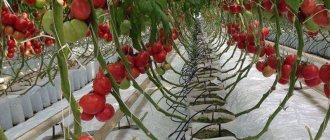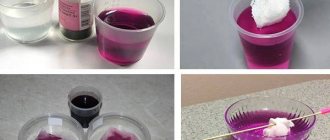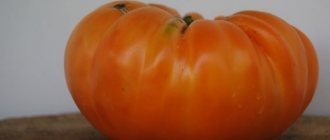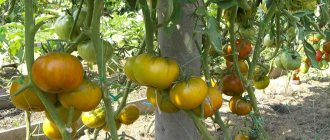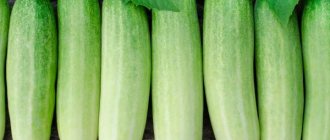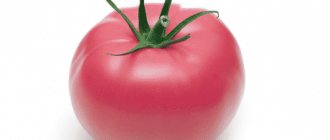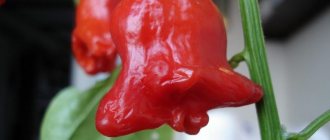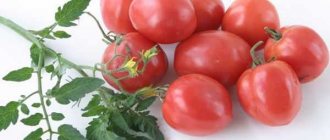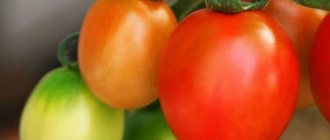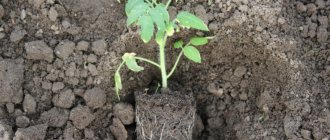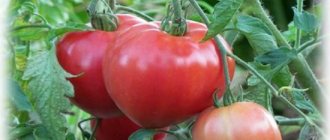Pink accordion is a heat-loving tomato native to Mexico. The original name of the variety is Pink Accordion. In all regions of Russia, these tomatoes are grown exclusively in greenhouses.
| Height | Landing location | Ripening time | Fruit color | Fruit size | Origin | Fruit shape |
| Tall | Greenhouse | Mid-season | Pink | Large | Variety | Flat-round |
Description of the variety
The Buyan variety is the result of the work of Siberian breeders: in 2012 it was bred specifically for cultivation in conditions of short and cool summers. It can be cultivated both in greenhouses and in open ground. The tomato is easy to care for, bears fruit well, and is ideal for homemade preparations.
Other name and varieties
It is not for nothing that people nicknamed it Fighter - this variety is not susceptible to climate change: it safely survives the cold and does not suffer from drought. Viruses and fungal infections are also not scary for him - the Fighter has excellent immunity to various kinds of microorganisms.
The fruits of this variety can be red or yellow. At the same time, the yellow variety of Buyan is no different in taste from the red one: the differences are only in color and in a more elongated shape, as can be seen in the photo.
Distinctive features
The Buyan tomato is a pure-varietal plant, bred not by crossing several varieties with each other, but by selecting the best plants. Its seeds retain all parental characteristics, which means that all characteristics of the plant are inherited.
This tomato belongs to a low-growing type of plant (determinant variety), that is, when it reaches a certain size, it stops growing, which is very convenient for gardeners: there is no need to tie up bushes or remove excess leaves. Thanks to this, Buyan is also good to grow in a greenhouse.
The plant tolerates temperature changes between day and night, short rainy summers, and high humidity. The period from sprouts to fruiting is one hundred days. Differs in early ripening.
Fruit characteristics, yield
The fruits of Buyan have a rounded, elongated plum-shaped shape. A ripe fruit can weigh on average from 80 to 150 g, has fleshy pulp and thick smooth skin, and a sweet and sour taste. There are few seeds in the pulp: one fruit has 3-6 seed chambers.
Description and characteristics of the variety
The variety is mid-season, 116-120 days, indeterminate, in height from 2 meters or more. The stem is powerful, the leaf is of regular shape, dark green. The bush produces quite a lot of green mass and needs staking, pinching and thinning of leaves. To obtain more fruits, the plant is formed into two stems.
The inflorescence is of an intermediate type, the first is formed after the 6th leaf. The fruits are pink, flat-round, ribbed, with a “fold”. The pulp is dense, very tasty, sweet and juicy. On a horizontal cut you can see small cavities between the wall and the seeds - this is a structural feature of the tomato.
How to grow seedlings
With the right approach, Buyan bears fruit regularly throughout its seasonal life. But in order to reap a bountiful harvest, you should take care of the seedlings in advance. Seeds can be bought in the store, but it is better to collect them yourself by the beginning of autumn from the largest fruits.
Seed preparation
To obtain seedlings, smooth, even seeds without defects are used.
Regardless of whether your seeds are purchased or collected yourself, before planting it is recommended to provide them with protection from viruses and infections - pickle them in a solution of potassium permanganate. The main thing here is not to overcook the seeds: 15 minutes is enough.
After potassium permanganate, the seeds should be washed with running water. Immediately before planting, they need to be kept in salt water - this increases the viability of future plants. Seeds from well-known manufacturers do not need to be subjected to such treatment - they are completely ready for sowing.
Container and soil
For planting, you can use whatever is at hand: ceramic pots, wooden or plastic boxes, cups, etc. However, it must be taken into account that the height of the sides should not exceed 10 cm. It is also worth taking care of drainage.
If the soil for seedlings is taken from the garden bed, then it needs to be disinfected, since the likelihood that it contains fungal infections and pest larvae is very high. You can disinfect the soil by holding it in a well-heated oven or pouring boiling water over it. You can etch with the same solution of potassium permanganate.
For your information. For reliable disinfection, soil treatment methods can be combined with each other.
For greater safety, it is better to buy already treated soil in gardening stores.
Sowing
By the end of March, you can start planting, sowing the seeds into the soil at a distance of 2 cm from each other and no deeper than 1 cm. A stable temperature of + 20-25 degrees should be maintained in the room with the seedlings. But the soil cannot be overheated; the seeds may die.
If it is not possible to provide constant heat, you can cover containers with seedlings with film to create a certain microclimate. If sowing is organized correctly, the first shoots will appear in 6-7 days.
Growing and care
In order for the seedlings to grow faster, it is necessary to create conditions for additional lighting.
After seedlings have appeared in the form of two or three leaves, it is necessary to transplant the seedlings into larger containers.
It is useful to feed the sprouts with an ash solution: 1 tablespoon of wood ash per 1 liter of cold water. There is no need to get carried away with fertilizing: 2-3 times before picking plants is enough.
Tomato Buyan
Every gardener who grows tomatoes knows what requirements a universal variety must meet. The main advantage of this vegetable is its good yield, taste and ease of care.
The Buyan tomato includes all these factors.
Buyan was first bred in Siberia in 2012 and is perfect for such a cool climate. There are two varieties of this variety: “Red Buyan” and “Yellow Buyan”. They differ slightly in the shape of the fruit, but in general they have the same properties. In the photo you can see both tomatoes.
Characteristics of the variety
Buyan tomatoes can be classified as early ripening varieties, since only about 100 days pass from the germination of seedlings to the ripening of the first tomatoes. The peculiarity of the tomato is that it is a bush plant, determinate, and not tall, as we are used to. Its height can reach up to 50 cm. The number of leaves is average. Inflorescences are formed every 2 leaves.
Care does not require much time and effort.
The tomato is suitable for both open ground and greenhouses. It tolerates any weather conditions very well: cold and drought. It has average disease resistance to bacteria, and is not susceptible to tobacco mosaic viruses.
It bears fruit very generously: from 1 m2 you can harvest about 25 kg of tomatoes. Tomatoes are cylindrical in shape, reminiscent of a plum. The skin is smooth and shiny. Unripe fruits are green with dark spots, ripe ones are deep red. The first tomatoes are always a little larger, but on average they weigh about 70 g. The number of seeds is very small, 4–5 seed chambers per tomato. The taste is sweet, but slightly sour, which is ideal for tomatoes. It’s a pity that the photo doesn’t convey the taste and smell, but we can see in cross-section how meaty and juicy they are.
This tomato variety is perfect for pickling, as the tomato skin is strong and will not crack. Can also be eaten fresh, stewed and dried. Suitable for freezing. But you won’t be able to store the Buyan tomato fresh for the winter.
So, the description of the Buyan variety showed that this is an almost ideal tomato. The variety does not require much attention; it does not require cutting off leaves or gartering, which is very surprising for such high-yielding tomatoes. It easily tolerates temperature changes and ripens very quickly.
With modern technologies, you don’t have to worry about this, because when frozen, the taste of fresh tomatoes is practically not lost.
Growing
This variety is sown in March. The seeds need to be placed in the soil to a depth of about 2 cm. It is very easy to do this in this way: seeds are sown on compacted soil, and a thin layer of soil mixed with peat is sprinkled on top. You can water the seedlings through a sieve or with a spray bottle. The boxes are covered with film and stored in a warm place. When the tomatoes germinate, the film is removed and the seedlings are placed in a place with good sunlight.
Picking should begin after the appearance of 1–2 full leaves. It is advisable to feed the sprouts at least 2-3 times before planting. We begin to harden when there is a week left before planting. After the frosts have ended, we begin to plant in the ground. The ideal density per 1m2 would be approximately 8–9 bushes.
Don't forget about feeding and loosening. Before flowering begins, it is recommended to feed tomatoes with mineral fertilizers. And after the first fruits appear, the plant needs potassium.
Diseases and pests
The Buyan variety persistently fights many diseases. This is facilitated by proper plant care. If you follow all the rules and recommendations for care, tomatoes are not afraid of any pests or diseases. But of course, it is simply impossible to protect the plant from everything. It happens that green spots appear on the fruits. This is normal for this variety. The spots disappear when the fruit is fully ripe. In addition, cracks may form. There may be several reasons:
- the soil is too wet (you may need to water the plants less often);
- excess complementary foods;
- a large number of fruits on the bush;
- insufficient amount of light.
For prevention, it is necessary to treat plants against late blight. These rules must be followed when growing all varieties of tomatoes, but it is “Fighter” that will please the owners with a bountiful harvest before anyone else.
Reviews
Let's sum it up
The description of this variety is completely true. Tomatoes are truly unpretentious and high-yielding. According to experienced gardeners, the Buyan variety is ideal for cold climates. Housewives who tried to grow it were very pleased.
Possible difficulties when growing the Buyan variety
For beginning gardeners, not everything always goes smoothly - both in germinating seeds and in further caring for plants.
Problems with seedlings
All conditions have been created, artificial lighting has been established, the seeds are carefully covered with film, but there are no sprouts. What is the reason? In addition to low-quality seeds, the following reasons can lead to this result:
- You may have planted the seeds too deeply in soil that is too heavy for them. The seeds simply suffocated under a layer of airtight soil;
- drainage is not thought out: the soil is peroxidized and fermented, which causes the seed to rot;
- you placed the box with seeds in a very hot room - perhaps next to heating appliances. The seeds could have become soggy from the oversaturation of steam.
Problem with sprouts
Your seeds have sprouted, but they do not bring joy: they are too faded and elongated, as if rickety. This may be for the following reasons:
- lack of light - you should take care of artificial lighting directly above the box with seedlings;
- When planting the seeds, you placed them too close to each other. Transplanting some of the sprouts into another container will help here. But such forced picking slows down the growth of the plant by 12-15 days, this must be taken into account before planting in open ground;
- Perhaps you overdid it with fertilizers, in which case it is better to transplant the seedlings into another, more “calm” soil.
Diseases
Buyan is resistant to most diseases, but if a greenhouse or garden is infected through the soil or garden pests (for example, aphids), then it may also be at risk.
Fungal diseases:
- Gray rot is a disease that affects closely planted plants. Characteristic signs of the disease are a white fluff-like coating on the fruits, spots on the leaves and stems. The drugs “Fundazol” or “Switch” will help fight the disease.
- Fomoz (brown rot) - the entire above-ground part of tomatoes is affected. The disease can be detected by the appearance of the leaves: they are covered with brown spots, which increase with the progress of the disease. If phomosis affects the fruits, then small black spots are visible on them, which also grow. In this case, the core of the fruit is also affected. In the initial stage of the disease, preparations based on copper oxychloride and Bordeaux mixture will help.
- Blackleg - a fungus that attacks the root system of a plant. Conditions for its reproduction can be the constant use of the same land, temperature changes, and high humidity. The fight against the disease will consist of treating the contaminated soil: watering with a solution of potassium permanganate, loosening, and, if necessary, replacing the soil.
Bacterial diseases:
- Bacterial cancer - bacteria infect the vessels of the plant, it begins to wither before our eyes. The disease progresses from the bottom up: from the lower leaves, which curl and wither, to the fruits, where black spots appear on them.
- Necrosis of the stem core - manifests itself during fruiting. Light spots appear on the leaves, and the leaves themselves curl. As a result of the disease, the tomato stem becomes hollow and brittle from the inside, and the plant dies.
- Bacterial fruit spotting affects early-ripening varieties planted in early spring. All parts of the plant suffer, the disease manifests itself in the form of growing spots on the leaves and stems. When blooming, the flowers are affected - they dry out.
In case of bacterial diseases, it is necessary to carry out protective measures in the form of weeding and removal of affected parts of the plant. If signs of disease are detected, plants must be sprayed with Abiga-Pik solution. The preparations “Fitolavin-300”, “Gamair” and “Baktofit” are recommended as the most effective in the fight against bacterial diseases.
For your information. Greenish spots may appear on the fruits of the Buyan variety. This is not a disease, but a feature of the variety. As the fruit ripens, the spots disappear.
Pests
Buyan tomatoes grown in greenhouses are most often attacked by spider mites. The tick feeds on the sap of the plant, biting through its leaves, which as a result begin to turn yellow, become covered with small dots and dry out.
Features of growing tomatoes Fighter, planting and care
sowing the seeds of this tomato variety for seedlings 50-55 days before the intended planting in the ground . Seedlings dive at the stage of two true leaves. When planting seedlings in a permanent place per 1 sq. It is recommended to place up to 6 plants per meter of plot. Planting pattern : 70 x 30 - 40 cm.
Further care for tomatoes consists of timely watering, fertilizing with complex mineral fertilizer, pinching (if earlier ripening is needed) and preventive measures to protect against diseases and pests.
A site about tomato varieties with truthful reviews from gardeners - Tomatland.
The nuances of growing Buyan in open ground and in a greenhouse
The Buyan tomato, as an early-ripening, low-growing variety, is ideal for growing in a greenhouse. It does not bush and does not create thickets; it does not need to be pinched or tied up.
Here are some recommendations for growing Buyan in a greenhouse:
- It is better to plant tomatoes along the wall of the greenhouse, and not across it - this way they will have more access to light.
- Create rows so that it is convenient to approach everyone: side rows along the walls, central rows in the center.
- Do not overfeed the soil with seedlings with fertilizers with a high nitrogen content.
- Tomatoes are light-loving plants, so access to light should be maximum.
- The greenhouse must be regularly cleaned, dead branches and leaves must be removed and taken outside, otherwise pests may appear.
When planting tomatoes in open ground, it is also necessary to adhere to certain standards, because properly planted bushes are the key to plant health:
- The soil in the beds must be prepared for planting in the fall;
- tomatoes grow well in the area after cucumbers, carrots, onions and cabbage;
- the distance between rows should not be less than 40 cm;
- Tomatoes can be planted in beds in a checkerboard pattern and parallel to each other, but the distance between the bushes must be sufficient to ensure access to processing each bush;
- Weeding, loosening the soil, removing yellowed and rotten parts of the plant are mandatory activities during the season.
Nuances of growing, characteristics and description of tomato variety Fighter
Reading time: 8 minutes
Just recently, growing tomatoes in the harsh Siberian climate seemed like a fairy tale. But thanks to the work of scientific breeders, vegetable varieties adapted to growth and fruiting in cold climates are increasingly appearing on the seed market. It is precisely these varieties that include the Fighter tomato variety, developed by Siberian breeders in 2000 and recommended for cultivation in Siberia and the Urals.
Description and characteristics of tomato Fighter
The variety was bred for cultivation in regions with cold climates, so it quickly adapts to any climatic conditions. Fighter tomatoes easily tolerate sudden temperature changes and frosts, and short heat and drought cannot harm the growth and fruiting of plants.
- The bushes grow compact, up to 45–50 centimeters in size, which makes it possible to grow tomatoes in small plots.
- Vegetables ripen after 90–100 days of active growth.
- During the ripening stage, tomatoes acquire a bright red hue with glossy, dense skin.
- The shape of the vegetables is elongated, similar to plum fruits.
- The taste of the fruits is neutral, with a characteristic taste and aroma of the culture.
- The average weight of Fighter tomatoes rarely exceeds the 100-gram mark, and specimens up to 170 grams are occasionally found.
Other name and varieties
For most gardeners and gardeners, the Fighter tomato variety is known as Buyan. This is what the developers called the new culture. But after state tests, the variety was renamed Fighter for its stable characteristics.
There are two varietal varieties of Buyan tomatoes. The more common red tomato variety and the lesser known yellow Fighter tomato. The only difference between these varieties is the shape of the fruit; in yellow vegetables it is more elongated.
Productivity
The variety is recommended for industrial cultivation. From 1 square meter of plantings up to 20 kilograms of fresh vegetables are obtained. In greenhouse growing conditions, yields can be increased.
Distinctive features
The main distinguishing feature of the Buyan variety is its ease of care. After all, the plant does not require additional formation and removal of stepsons, which is not typical for a vegetable crop.
It is also worth noting that the first harvest of vegetables ripens the largest. Some specimens of the first vegetables reach the 200-gram mark.
Advantages and disadvantages of Buyan tomatoes
In order to avoid mistakes when growing Buyan tomatoes, you need to become familiar with all the strengths and weaknesses of the vegetable variety.
- The variety is resistant to negative environmental influences and tolerates both sudden cold snaps and drought.
- The first crops are harvested in mid-June.
- Good natural immunity to some fungal and viral infections.
- Easy to grow and care for.
- Increased yields.
- Plants do not require additional supporting structures or garters and are not prone to overgrowth.
Fighter tomatoes are suitable for growing in open ground or in greenhouses.
The main disadvantage is the short shelf life of ripened fruits and the impossibility of transporting them over long distances.
The nuances of growing crops
Tomatoes of the Buyan variety are grown by seedlings. In the southern regions, it is allowed to sow seeds directly into open ground.
Preparation of planting material
Seeds collected independently require preparation and processing before sowing.
- Planting material is calibrated by selecting the most viable and intact seeds.
- Next, the seeds are dipped into a manganese solution for 20–30 minutes and treated with a growth stimulator.
- To harden, the seed material is wrapped in a damp cloth and sent to the lower compartment of the refrigerator or cellar for 2 days.
- After hardening, the seeds are placed in a warm, sunny place for germination.
- As soon as the first shoots appear from the seeds, they are planted in the soil
Container and soil
For planting seeds, select containers with low sides.
- Before planting, the containers are thoroughly washed and treated with a manganese solution.
- Fine crushed stone is placed at the bottom of the container and a fertile, loose soil mixture is poured.
- It is fashionable to purchase ready-made soil for growing seedlings in flower shops or make it yourself by mixing soil from the site with peat, humus and minerals.
Experienced gardeners advise heating the self-prepared soil in the oven at a temperature of 60–70 degrees. Such an event will allow you to get rid of unwanted parasites, fungi and bacteria in the soil.
Sowing seedlings
In containers with fertile soil, grooves or small depressions are made for planting seeds.
- Planting material is laid out in holes and sprinkled with soil, and the top is irrigated with a sprayer.
- The containers with the planted seeds are covered with film and sent to a warm place.
- As soon as the first shoots appear from the ground, the covering material is removed and the plants are moved to a warm, well-lit room.
Caring for her
Caring for seedlings includes watering, picking and fertilizing.
Young plants begin to plant, or plant, after the appearance of 2–4 tomato leaves. To do this, select spacious pots or boxes in which the seedlings will develop until they are transferred to a permanent place of growth.
Important! 10–14 days before planting a vegetable crop in the ground, the seedlings are hardened by taking the containers with tomatoes outside.
Transplantation to a permanent place
The seedlings are transferred to open ground at the age of 55–60 days from the day the seeds are planted. Tomatoes are planted in the greenhouse 2-3 weeks earlier.
The area for planting tomatoes is prepared in the fall.
- The soil is dug up, loosened, mixed with organic matter and mineral fertilizers.
- In the spring, planting holes 30–40 centimeters deep are made in the prepared area.
- The distance between plantings is left up to 30 centimeters, between rows up to 50 centimeters.
- The seedlings are transferred to the prepared holes, carefully removing them from the container along with a lump of earth.
- The bushes are sprinkled with fertile soil and watered.
After finishing the work, the beds are mulched with humus or dry grass.
Rules for caring for the variety
Tomatoes of the Fighter variety are not demanding in care, but timely watering and fertilizing of the plants are necessary.
Watering and fertilizing
Buyan tomatoes are characterized by increased resistance to hot climates and drought. Therefore, irrigation work is carried out as the soil dries out. During the rainy season, watering is reduced or abandoned altogether.
During the growing season, plants are fertilized 2–3 times with mineral complexes based on potassium and phosphorus.
Bush formation
The bushes grow compact, so the plants do not require additional formation. But we must not forget about loosening the soil and removing weeds.
Prevention of diseases and pests
Preventive work against fungal, viral infections and harmful insects is carried out at the beginning of the growing season. Repeat the treatment of bushes with chemical or biological preparations as necessary. Also, experienced gardeners and gardeners use traditional methods of combating diseases and pests.
Harvesting and storing the tomato crop Fighter
Tomatoes ripen at the same time, which reduces harvest time. Ripe fruits are not subject to long-term storage and long-distance transportation. Therefore, it is advisable to quickly process the ripened harvest.
At the stage of technical maturity, vegetables can be stored for 2 to 4 months.
Possible difficulties during cultivation
The Buyan tomato variety is so easy to care for and grow that it is recommended as a teaching tool for beginning vegetable growers.
The main mistakes when cultivating tomatoes of this variety are as follows:
- When growing vegetables in greenhouses, the premises are ventilated daily. Otherwise, the greenhouse will become a breeding ground for pests and fungal diseases.
- To avoid additional care for tomatoes, lay a thick layer of mulch on the beds.
- We also must not forget about weeding the beds from weeds. After all, weeds are the main carriers of harmful insects, fungi and viruses.
| Premium seeds | |
| Manufacturer country | Russia |
| additional characteristics | |
| Weight | 5 g |
| In boxing | 200 pcs. |
| Packing height | 0.1 |
| Material | Seeds |
| Packing depth | 15 |
| Packing width | 8 |
| Type of individual packaging | Without packaging |
| Amount in a package | 10 pieces |
| Number of items in the set | 10 |
| Package | Colored |
| Type of soil | Universal |
| Product volume | 0.0122 |
| Boxing volume | 2.432 |
| Packaging volume | 0.012 |
| RosZakup | Yes |
| Ripening time | Average |
| Sowing seedlings | February March |
| Features of cultivation | Universal |
| Variety or hybrid | Variety |
| Growing season, days | 113 |
Harvesting and application
Buyan produces a harvest three months after germination, so if your tomatoes sprouted in April, then in June you will receive the first fruits. They need to be collected regularly, but it is better to leave one ripe fruit on each bush, as it contributes to the ripening of the remaining fruits.
If you miss time, the fruits will become overripe, which means they will lose their beneficial qualities and appearance, and become loose and tasteless. If you want fresh tomatoes for the table, it is better to pick them when they are ripe and bright red or yellow.
Buyan tomatoes are an excellent product for canning. Their fruits, both ripe and unripe (green), can be canned, pickled and salted. It should be borne in mind that these tomatoes do not last long when fresh. It’s better if they go from the garden to canned food or juices. Thanks to its dense pulp, the tomato is suitable for both drying and freezing.
Tomatoes with a “masculine character” from Premium Seeds
Adding an article to a new collection
Last summer was long and cold, and not all tomato varieties and hybrids liked such extreme conditions. The harvest was in jeopardy! And only unique new hybrids were able to adapt well and withstand the vagaries of nature with dignity.
Winter is the best time for gardeners to start preparing for the new season. And it’s time to sum up the results of the past sowing campaign, analyze mistakes, share experiences, and choose new varieties.
Requirements for the quality of tomatoes
In the climatic conditions of the middle zone with sudden changes in weather and temperature fluctuations, everyone who grows vegetables on their own has to make this choice. After all, only the hardiest, most reliable and fastest-ripening hybrids can produce a guaranteed harvest. They are also the most environmentally friendly, because you can protect your crop from late blight without chemicals only if you grow early-ripening varieties and hybrids of tomatoes.
At the same time, tomatoes should be beautiful in appearance and pleasant in taste. All these qualities are combined by hybrids bred by the breeders of the Premium Seeds , who took into account many different factors - climate characteristics, soil characteristics, disease resistance of tomatoes, and, first of all, productivity. These tomato bushes don’t mind any “cataclysms” - they are strong, healthy, all strewn with fruits. And their names are unusual and memorable. Take note!
Ruddy man F1
This is the tomato you've been looking for! Sweet, tasty and most importantly - its yield has been tested in the harshest conditions and is therefore guaranteed! This ultra-modern hybrid of a new class is intended for cultivation in open ground and under film covers in all regions of Russia.
It is early ripening - no more than 90-95 days pass from germination to the beginning of ripening, determinate (height - 75-85 cm). The fruits are a delightful crimson color, round in shape, large (150-250 g). They are incredibly tasty thanks to their fleshy and juicy sweet-sugar pulp.
They can be used for all types of processing. In addition, the hybrid Ruddy Man F1 is resistant to major tomato diseases.
Golden man F1
A trouble-free early-ripening determinate hybrid with a height of 135-145 cm. From germination to the beginning of ripening - 92-95 days. The fruits are round, dense, weighing 200-220 g, amber golden-orange in color. Productivity – up to 18-19 kg/sq.m. Indeed, the fruits are worth their weight in gold! Their sweet and tender pulp contains large quantities of vitamins C, E, group B, as well as powerful antioxidants - valuable lycopene and myocin.
Since there are very few organic acids in the pulp, even in processed form these tomatoes will not be sour, will not cause heartburn and will not cause allergies, like their red “brothers”. Thanks to their thick skin, which almost never cracks, tomatoes are easy to transport.
The hybrid Golden Man F1 is resistant to Alternaria and Tobacco Mosaic Virus (TMV), and due to its early ripening, the fruit crop ripens earlier than late blight develops and begins to spread throughout the plantation.
Kuzmich F1
Super new of the year! A true tomato authority! This “gardener” “knows” how to grow a rich harvest in any season. Almost not demanding of care, Kuzmich is generous and responsive to care. Moreover, the fruits set in any weather, both in film greenhouses and in open ground. Prepare to collect these tomatoes for a very long time - there will be a lot of them!
The hybrid is early ripening (88-90 days from germination to the beginning of ripening), 90-95 cm high. Fruits weighing 140-200 g, intense red color, round, fleshy, very tasty, pulp without voids and white veins inside, the skin does not crack.
Kuzmich F1 tomatoes are a masterpiece of taste and yield. In addition to its many advantages, the hybrid is resistant to Alternaria and TMV. Needless to say, with such a ripening period, Kuzmich is not afraid of late blight either!
Eligible bachelor F1
Not only the name of this hybrid arouses curiosity, but also tomato plantings invariably attract the eye with an abundance of ovaries on heavy clusters! Starting from the 3rd internode, brushes are formed at each node! The fruits weigh 100-130 g, without a green spot at the stalk, rich crimson color, without voids, cylindrical, fleshy, do not crack, very tasty, all as if chosen - handsome.
The winner of the “Best Tomato for Canning and Pickling” competition, this “bachelor” is so good that he probably won’t find a worthy “pair” for a long time.
Early ripening (90-93 days from germination to the beginning of ripening), determinate (height 90-110 cm), with a scattered harvest. Suitable for growing in open ground and film greenhouses, it grows in any weather.
The hybrid Enviable Bachelor F1 is resistant to Alternaria and TMV, and due to the dense skin of the fruit, it is also insensitive to late blight.
Emerald domes F1
This hybrid found itself in the company of “male” names not only because of its endurance and fertility. It is thanks to such varieties and hybrids that the popularly beloved tomato received the proud name from the French - pomme d'amour (“pomme d'amour”) - the apple of love, or the cupid apple. The fact is that only the ripe green fruits of this tomato contain the alkaloid solanine in an amount that causes a love mood. But in ripe red and yellow tomatoes there is almost no this substance.
Advantages and disadvantages of the variety
Although Buyan was bred for regions with cold weather conditions, it has become popular everywhere, as it has a number of advantages that farmers love. One of them is harvest abundance: up to 8 kg of fruits are obtained from one square meter. At the same time, the variety is unpretentious: it patiently tolerates aridity and temperature changes. Such common diseases as late blight and tobacco mosaic are not a threat to Buyan.
Many gardeners also liked the appearance of the fruit: medium-sized, neat, smooth, shiny. During heat treatment, the tomato skin remains intact and does not crack. In home canning and drying, all the taste and aroma are preserved.
Farmers include the following disadvantages of the variety:
- inability to store fresh for a long time;
- When ripening on the bush, the skin of tomatoes often bursts. This fact in itself does not cause damage, but microbes that are harmful to humans can settle in the cracks.
Farmer reviews
Let's consider the reviews of summer residents who have already grown the Buyan tomato.
Margarita: “I bought a bag because I had already heard that this variety is “for the lazy.” The seeds sprouted with a bang. I didn’t particularly choose the place for the seedlings: the only free space was in the shade of the tree. Due to the fact that there was not enough light for them, the tomatoes appeared later than other varieties that I planted on the site. But I collected fruits regularly. The bush is low, shaggy, it does not need to be trimmed or tied up. Just a beauty, not a plant!”
Alina: “We are beginners as gardeners, but Buyan’s seedlings did not disappoint: we took them to the dacha without any hassle, and they were still lush, fresh, nothing wilted or broke. Just as they were planted in the ground, they grew - no worries with them, no hassle! The tomatoes themselves are oval, smooth, a sight for sore eyes. I made salads from them all summer. True, the skins on them often burst, but since I immediately processed them in the kitchen, it was okay, not fatal.”
Igor: “It’s a good variety, it didn’t disappoint. For the sake of experiment, I planted them in the greenhouse with other tomatoes. What was surprising was that the seedlings, unlike other varieties, did not stretch. I didn't bother with it much. Planted in April, starting in June, the bushes bore fruit all summer. The harvest was abundant; every day I left the greenhouse with two full buckets of fruit. I’ll definitely plant it next year.”
